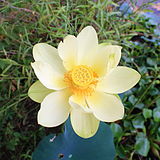Nelumbo lutea
| Nelumbo lutea | |
|---|---|

| |
| Scientific classification | |
| Kingdom: | Plantae |
| Clade: | Tracheophytes |
| Clade: | Angiosperms |
| Clade: | Eudicots |
| Order: | Proteales |
| Family: | Nelumbonaceae |
| Genus: | Nelumbo |
| Species: | N. lutea
|
| Binomial name | |
| Nelumbo lutea | |
| Synonyms[3] | |
| |
Nelumbo lutea is a species of
Description
American lotus is an emergent aquatic plant. It grows in lakes and swamps, as well as areas subject to flooding. The roots are anchored in the mud, but the leaves and flowers emerge above the water's surface. The petioles of the leaves may extend as much as 2 m (6.6 ft) and end in a round leaf blade 33–43 cm (13–17 in) in diameter. Mature plants range in height from 0.8 to 1.5 m (2.6 to 4.9 ft).[5]
Flowering begins in late spring and may continue into the summer. The specific name means "yellow" in Latin and refers to the flowers, which may be white to pale yellow. The flowers measure 18–28 cm (7.1–11.0 in) in diameter and have 22-25 petals.[5]
Ecology
It is the larval host plant of the American lotus borer, Ostrinia penitalis.[6]
Conservation status
However, Nelumbo lutea populations are declining in the U.S. due to habitat destruction, and it has been listed as threatened or endangered in New Jersey, Michigan, and Pennsylvania, and extirpated in Delaware.[7] Their populations have a low level of genetic diversity, showing variation among different populations rather than within populations.[8]
Range
The native distribution of the species is Minnesota to Oklahoma, Florida, Mexico, Honduras, and the Caribbean.

It was apparently distributed northwards in the United States by Native Americans who carried the plant with them as a food source.[9]
Uses
This plant has a large tuberous
The species is widely planted in ponds for its foliage and flowers. American Lotus spreads via creeping rhizomes and seeds. This species has been crossed with
Other media
Disney's character
References
- ^ "NatureServe Explorer 2.0". explorer.natureserve.org.
- ^ Maiz-Tome, L. 2016. Nelumbo lutea. The IUCN Red List of Threatened Species 2016: e.T169072A1270473. https://dx.doi.org/10.2305/IUCN.UK.2016-1.RLTS.T169072A1270473.en. Accessed on 12 August 2023.
- ^ a b "Nelumbo lutea (Willd.) Pers". Plants of the World Online. Royal Botanic Gardens, Kew. Retrieved 12 August 2023.
- ^ "Nelumbo lutea". Integrated Taxonomic Information System.
- ^ ISBN 978-0-88192-684-2.
- ^ "Species Ostrinia penitalis - American Lotus Borer - Hodges#4946 - BugGuide.Net". bugguide.net. Retrieved 2019-09-26.
- .
- S2CID 208570832.
- ^ Wiersema, John H. (1997). "Nelumboanaceae". Flora of North America. 3.
- ISBN 0-486-20504-5.
- ISBN 0-86730-784-6.
- ISBN 0-394-50432-1.
- OCLC 244766414.






